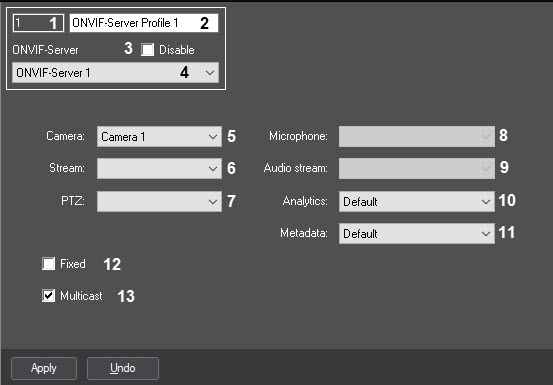
Go to documentation repository
The ONVIF-Server Profile object is designed to configure the ONVIF device channel.
The settings panel of the ONVIF-Server Profile object is shown in the figure.
Basic elements of the settings panel of the ONVIF-Server Profile object are described in the table.
| # | Parameter name | Method for setting the parameter value | Parameter description | Representation | Default value | Value range |
| 1 | ID* | Automatically | Displays the identification number of the ONVIF-Server object in the digital video surveillance system with distributed architecture | Sequence of numbers | - | Depends on the number of the ONVIF-Server objects in the digital video surveillance system with distributed architecture |
| 2 | Name* | Specify the value in the field | Sets the name of the ONVIF-Server object in the digital video surveillance system with distributed architecture | Latin, Cyrillic and service characters | PTZ device | A line containing a sequence of any symbols (letters, digits, service characters apart from > and < symbols), not case-sensitive. Number of symbols – from 1 to 60. |
| 3 | Disable | Set the checkbox checked | Sets the state (enabled or disabled) of the ONVIF-Server object in the digital video surveillance system with distributed architecture | Boolean type | No | Yes – the ONVIF-Server object is disabled and not in use. No – the ONVIF-Server object is enabled and in use. |
| 4 | Onvif-Server | Select in the list | Sets the parent ONVIF-Server object to which the ONVIF-Server Profile object corresponds in the digital video surveillance system with distributed architecture | The names of the ONVIF-Server objects registered in the system | The name of the ONVIF-Server parent object | Depends on the number of the ONVIF-Server objects in the digital video surveillance system with distributed architecture |
| 5 | Camera | Automatically | Sets the Camera object corresponding to the ONVIF-Server Profile object | The names of the Camera objects registered in the system | - | Depends on the number of the Camera objects in the digital video surveillance system with distributed architecture |
| 6 | Stream | Automatically | Sets the video stream that is transmitted via the ONVIF-Server Profile object | List of available video streams | - | Depends on the number of activated camera streams |
| 7 | PTZ | Automatically | Sets the PTZ object, used for PTZ control, corresponding to the ONVIF-Server Profile object | List of PTZ objects corresponding to the selected Camera object | - | Depends on the number of PTZ objects created and configured in the system |
| 8 | Microphone | Automatically | Sets the Microphone object corresponding to the selected Camera object | List of Microphone objects corresponding to the selected Camera object | - | Depends on the number of Microphone objects created and configured in the system |
| 9 | Audio stream | Automatically | Sets the audio stream to be synchronously transmitted with video | List of available audio streams | - | Depends on the number of available audio streams |
| 10 | Analytics | Automatically | Sets the stream to transmit analytics | List of available streams | - | Depends on the number of available streams |
| 11 | Metadata | Automatically | Sets the stream to transmit metadata | List of available streams | - | Depends on the number of available streams |
| 12 | Fixed | Set the checkbox checked | Disables deleting the ONVIF-Server Profile object using the driver | Boolean type | No | Yes – the ONVIF-Server Profile object cannot be deleted using the driver No – the ONVIF-Server Profile object can be deleted using the driver |
| 13 | Multicast | Set the checkbox checked | Enables video transmission via ONVIF-Server in the multicast mode | Boolean type | No | Yes – video can be transmitted in the multicast mode. Note. There are some extra actions besides setting the checkbox checked in order to enable video transmission in the multicast mode – see Configuring getting video using ONVIF-Server module. No – video cannot be transmitted in the multicast mode. |
